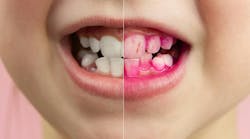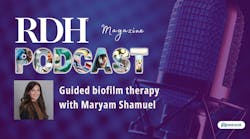Clinical Tips: The benefits of disclosing solution
Listen to the article on our podcast!
Plaque disclosing: Some clinicians love it, while others are happy to have left it in hygiene school. Out of all the tasks expected of the hygienist during a typical 40- or 60-minute preventive visit, many feel that there simply isn’t enough time for disclosing and individualized oral hygiene instruction.
Education and motivation
Why do we disclose, anyway? Fasoulas and others offer seven reasons1:
- To establish the level of the user’s oral hygiene
- To raise awareness of the need for biofilm removal
- To provide personalized instructions and incentives for better oral hygiene
- To facilitate user self-assessment
- To measure oral hygiene effectiveness
- To evaluate prevention and training programs for better oral hygiene
- To enable studies on biofilm identification
Disclosing can serve as an effective educator and motivator for our patients. Seeing the brightly colored plaque biofilm on one’s teeth reinforces the importance of consistent, detailed home habits and allows the practitioner to demonstrate proper plaque removal techniques. Aside from assisting the patient in reducing their risk for caries and periodontal disease, the increased efforts in the individual’s home care can also result in less plaque and calculus removal at future hygiene visits.
Different types, abilities, and applications
What does a dental professional need to know about disclosing before introducing it clinically? First, it’s worth knowing that disclosing agents are available in a variety of preparations and formulations. Some prefer the chewable tablets that can be handed to patients for self-application, while others may choose liquids and gels that can be applied by the practitioner. Although based largely on the professional’s personal preference, it seems that the majority of clinicians like liquids and gels for in-office use and send tablets home with the patient for personal accountability.
Clinicians should know that not every disclosing agent has the same abilities. There are simple formulas that dye plaque one color, while more advanced formulas provide two- or three-toned variations within the same product to differentiate plaque types. Two-toned solutions allow for the identification of both new and mature biofilm. This can help educate the patient on areas repeatedly missed during their at-home plaque removal routine. Three-toned solutions offer an additional identifier: acid-producing biofilm. This can be especially beneficial when investigating oral pH, the diversity in the microbiome (or lack thereof), or performing risk assessments.
Additionally, one should know that different preparations of disclosing agents require different applications. Most tablets require the individual to chew fully while wiping their teeth with the tongue to spread the agent. Liquids are typically applied with either a cotton-tipped applicator saturated with the product or by placing some drops underneath the person’s tongue and instructing them to wipe their tongue across their teeth. Gels can be applied with a standard brush tip applicator, microbrush, or swab.
After applying the agent, the teeth are rinsed, and plaque is assessed. Some clinicians take clinical photos to document their findings in the patient’s records. The patient can see their disclosing results with a handheld mirror while the provider discusses their observations and recommendations for improved plaque removal. This creates a smooth segue into traditional hygiene instrumentation or guided biofilm therapy.
Little effort, large impact
When performed intentionally, plaque disclosing and the subsequent instruction should take only a few minutes, although more complex cases may require more time and attention. When considering all the benefits, it’s worth making the time. Disclosing isn’t just for hygiene school—it’s a powerful tool for professional preventive care.
Editor's note: This article appeared in the April/May 2025 print edition of RDH magazine. Dental hygienists in North America are eligible for a complimentary print subscription. Sign up here.
Reference
- Fasoulas A, Pavlidou E, Petridis D, Mantzorou M, Seroglou K, Giaginis C. Detection of dental plaque with disclosing agents in the context of preventive oral hygiene training programs. Heliyon. 2019;5(7):e02064. doi:10.1016/j.heliyon.2019.e02064
About the Author

Bethany Montoya, MBA, RDH
Bethany Montoya, MBA, RDH, is a practicing dental hygienist, educator, industry key opinion leader, and editorial director of DentistryIQ’s Clinical Insights newsletter. She has a passion for advancing modern disease prevention. She specializes in exploring the intersection of clinical practice, professional growth, and innovation within oral health care. Through her writing, she aims to educate, inspire, and spark meaningful dialogue in the dental community. She can be reached at [email protected].


